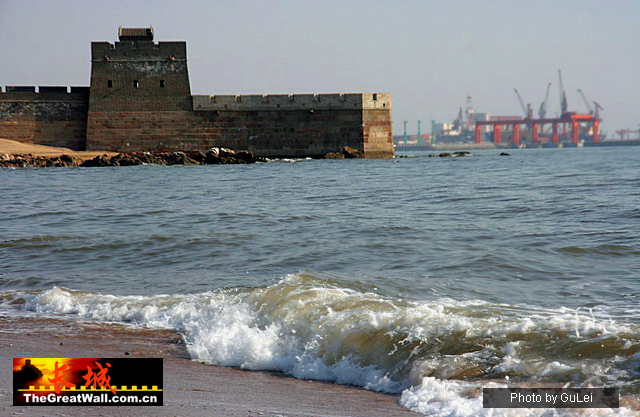|
|
 |
| |
| Laolongtou Great Wall: A brief
introduction
|
|
The Laolongtou section of the Great Wall.

The Laolongtou (Old Dragon Head) Great Wall is on of part the Ming Dynasty (1368-1644) Great Wall. Lying five kilometers south of Shanhaiguan Pass, It extends about 20 meters into the Bohai Sea like a dragon drinking water, hence its name.
Laolongtou comprises the Chenghai Pavilion, the Nereus Temple, the Estuary Stone City, the Jinglu Beacon Tower, the Nanhaokou (Southern Estuary) Pass and the Ninghai City. In 1900, the Eight Power Allied Force invaded Shanhaiguan Pass and destroyed the Laolongtou. In 1984, it was rebuilt by the people of Shanhaiguan.
The Chenghai Pavilion is most celebrated architectural structure. It is a two-story building built with bricks and wood. Emperors in the Qing Dynasty including Kangxi, Yongzheng and Qianlong once visited there on their way to Mukden (Shenyang City) to worship their ancestors and left many poems and inscriptions. A plaque with four Chinese characters 'Yuan', 'Qi', 'Hun' and 'Mang' and a pair of couplets written by Qianlong still hangs on the lintel and columns of the hall.
Poems from other famous literary figures are inscribed on the tablets which are embedded on the walls. In front of the Chenghai Pavilion is an ancient stone tablet which is inscribed with four Chinese characters 'Tian', 'Kai', 'Hai' and 'Yue'. It is about three meters high and one meter wide. It is said that the stone tablet was established by Xue Rengui, a famous and legendary general in Tang Dynasty (618-907) who conquered Korea.
Reconstructed in 1988, the Nereus Temple is about 350 meters from the Laolongtou. It consists of many archways, the Drum Tower, the Nereus Hall, the trestle bridge and the Hall of the Goddess of Heaven; the Nereus Hall and the Hall of the Goddess of Heaven being the main structures of the temple. Inside the temple are sculptures of Nereus, Goddess of Heaven, Eight Immortals and the Door Gods. A plaque inscribed by Qianlong hangs on the door lintel.
The Estuary Stone City was built by Qi Jiguang- famous general of the Ming Dynasty. Its a city measuring about nine meters high and eight meters wide which extends approximately 22 meters into the sea. The city is built on natural reefs and huge rocks thrown into the sea to act as foundations. It served as a defence fortification designed to resist the aggression of the minorities.
Laolongtou Great Wall
Jinglu Beacon Tower was built in 1565. Following extensive reconstruction, the beacon tower stands about 15 meters high. The tower has three rooms which are connected by six door openings and nine windows in all, making the rooms well ventilated. It functions as a defence system together with the Chenghai Pavilion, Nanhaikou (Southern Estuary) Pass.
The Ninghai City and the the Nanhaikou (Southern Estuary) Pass are also worth a visit. The Ninghai City was built in the Ming Dynasty. On the north and west city gates are two embrasured watchtowers guarding the South China Sea. The Nanhaikou (Southern Estuary) Pass is the No.1 Pass of the Ming Dynasty Great Wall according to the location order.
( Photograph : Gu Lei) |
| |
|
|

